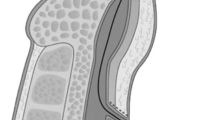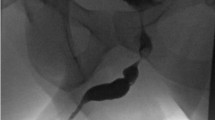Abstract
Urethrocutaneous fistulas complicating hypospadias repair appear a common problem. There appears less data in the literature regarding the risk and management of recurrent fistulas. A retrospective review of urethrocutaneous fistulas complicating hypospadias repair was performed to evaluate their aetiology, management and outcome. Between 1993 and 2003, 1,753 patients had a hypospadias repair at our institution. Overall 123 (7%) boys developed a fistula, although detailed information was available on 117 patients only. Median age was 3.5 years at the time of fistula repair; 13% had anterior, 57% had middle and 30% had posterior hypospadias. The most common primary surgical procedure was a Durham Smith two-stage repair in 29% (n = 34), followed by a Tubularised Incised Plate urethroplasty in 19% (n = 22) and an Onlay in 14% (n = 16). Thirty-one (27%) patients developed a recurrent fistula, 9 (29%) of which recurred following a second repair. None recurred after a third repair. The risk of a recurrent fistula after an initial distal fistula repair was 12.5% and after a posterior fistula was 62% (χ2 = 15.4, P = 0.001). Use of a stent, suture type, numbers of fistula and closure attempts did not influence the recurrence rate. Undiagnosed distal obstruction was thought to be related to 27 of 117 first fistula repairs (23%) and 4 of 31 second fistula repairs (13%). The risk of recurrent urethrocutaneous fistula was increased in those boys with a posterior fistula, following a simple repair or when there was evidence of distal urethral obstruction.
Similar content being viewed by others
References
Baskin LS, Duckett JW (1998) Hypospadias. In: Stringer MD, Oldham KT, Mouriquand PDE, Howard ER (eds) Pediatric surgery and urology: long term outcomes. WB Saunders Co Ltd, London, pp 559–567
Baskin LS, Ebbers MB (2006) Hypospadias: anatomy, etiology, and technique. J Pediatr Surg 41:463–472. doi:10.1016/j.jpedsurg.2005.11.059
Belman AB (2002) Hypospadias and chordee. In: Belman AB, King LR, Kramer SA (eds) Clinical pediatric urology. Martin Dunitz, London, pp 1061–1092
Stoll C, Alembik Y, Roth MP et al (1990) Genetic and environmental factors in hypospadias. J Med Genet 27:559–563
Pierik FH, Burdorf A, Nijman JM et al (2002) A high hypospadias rate in The Netherlands. Hum Reprod 17:1112–1115. doi:10.1093/humrep/17.4.1112
Smith ED (1997) The history of hypospadias. Pediatr Surg Int 12:81–85. doi:10.1007/BF01349969
Snodgrass W (1994) Tubularized, incised plate urethroplasty for distal hypospadias. J Urol 151:464–465
Horton CE, Devine CJ (1973) Urethral fistula. In: Horton CE (ed) Plastic and reconstructive surgery of the genital area. Brown & Co, Boston, pp 397–403
Shapiro SR (1984) Complications of hypospadias repair. J Urol 131:518–522
Landau EH, Gofrit ON, Meretyk S et al (2003) Outcome analysis of tunica vaginalis flap for the correction of recurrent urethrocutaneous fistula in children. J Urol 170:1596–1599. doi:10.1097/01.ju.0000084661.05347.58
Holland AJA, Smith GHH, Cass DT (2000) Clinical review of the ‘Snodgrass’ hypospadias repair. Aust N Z J Surg 70:597–600. doi:10.1046/j.1440-1622.2000.01906.x
Hadidi AT (2004) Single stage versus two stage repair. In: Hadidi AT, Azmy AF (eds) Hypospadias surgery. Springer, Berlin, pp 261–267
Hadidi AT (2004) Fistula repair. In: Hadidi AT, Azmy AF (eds) Hypospadias surgery. Springer, Berlin, pp 277–282
Sunay M, Dadali M, Karabulut A et al (2007) Our 23-year experience in urethrocutaneous fistulas developing after hypospadias surgery. Urology 69:366–368. doi:10.1016/j.urology.2006.12.012
Baskin LS (2006) Hypospadias. In: Stringer MD, Oldham KT, Mouriquand PDE (eds) Pediatric surgery and urology: long-term outcomes. Cambridge University Press, Cambridge, pp 611–620
Snodgrass W (1994) Tubularised, incised plate urethroplasty for distal hypospadias. J Urol 151:464–465
Snodgrass W, Koyle M, Manzoni G et al (1996) Tubularized incised plate hypospadias repair: results of a multicenter experience. J Urol 156:839–841. doi:10.1016/S0022-5347(01)65835-X
Park JM, Bloom DA (2006) Hypospadias repair. In: Spitz L, Coran AG (eds) Operative pediatric surgery. Hodder Arnold, London, pp 841–859
Hansson E, Becker M, Aberg M et al (2007) Analysis of complications after repair of hypospadias. Scand J Plast Reconstr Surg Hand Surg 41:120–124. doi:10.1080/02844310701228669
Waterman BJ, Renschler T, Cartwright PC et al (2002) Variables in successful repair of urethrocutaneous fistula after hypospadias surgery. J Urol 168:726–730. doi:10.1016/S0022-5347(05)64734-9
Eardley I, Whitaker RH (1992) Surgery for hypospadias fistula. Br J Urol 69:306–310
Horton CE, Devine CJ, Graham JK (1980) Fistulas of the penile urethra. Plast Reconstr Surg 66:407–418
Mouriquand PDE, Persad R, Sharma S (1995) Hypospadias repair: current principles and procedures. Br J Urol 76:9–22
Snodgrass W (1999) Does tubularized incised plate hypospadias repair create neourethral strictures? J Urol 162:1159–1161. doi:10.1016/S0022-5347(01)68110-2
Snodgrass WT, Lorenzo A (2002) Tubularized incised-plate urethroplasty for hypospadias reoperation. BJU Int 89:98–100. doi:10.1046/j.1464-410X.2002.02532.x
Holland AJ, Smith GH, Ross FI et al (2001) HOSE: an objective scoring system for evaluating the results of hypospadias surgery. BJU Int 88:255–258. doi:10.1046/j.1464-410x.2001.02280.x
Author information
Authors and Affiliations
Corresponding author
Rights and permissions
About this article
Cite this article
Holland, A.J.A., Abubacker, M., Smith, G.H.H. et al. Management of urethrocutaneous fistula following hypospadias repair. Pediatr Surg Int 24, 1047–1051 (2008). https://doi.org/10.1007/s00383-008-2202-0
Accepted:
Published:
Issue Date:
DOI: https://doi.org/10.1007/s00383-008-2202-0




